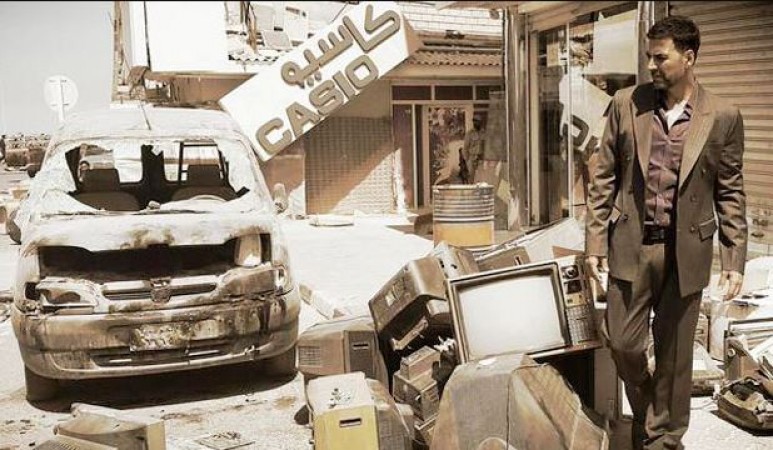
With its potent ability to take viewers to various eras and locations, cinema is a very effective medium. An outstanding illustration of this is the movie "Airlift," which expertly re-created the atmosphere of Kuwait in the 1990s on sets located in Ras Al-Khaimah, United Arab Emirates (UAE). This article will go into detail about the meticulous set design and construction process that turned Ras Al-Khaimah into a convincing recreation of a war-torn Kuwait during the Gulf War. This article will examine the "Airlift's" cinematic magic, from historical accuracy to the difficulties encountered during filming.
Understanding the historical setting of the movie is crucial before delving into the specifics of the set design in Ras Al-Khaimah. Based on the actual evacuation of Indian expatriates from Kuwait during the Gulf War in 1990, "Airlift" depicts the event. In order to ensure the safe return of thousands of Indians who were stranded in Kuwait, Akshay Kumar's character Ranjit Katyal, played in the movie, made heroic efforts.
The Gulf War, which broke out when Iraq invaded Kuwait in August 1990, had a significant effect on the area and the entire world. The evacuation of civilians turned into a significant humanitarian undertaking as a result of the war's widespread destruction and chaos in Kuwait. It was extremely difficult for the filmmakers to accurately recreate this turbulent time.
Filmmakers frequently have to decide between shooting on location and building elaborate sets in controlled environments. In the case of "Airlift," the directors chose the latter, choosing Ras Al-Khaimah, one of the seven emirates of the UAE, as the setting for their ambitious project.
Ras Al-Khaimah provided the filmmakers with a number of benefits. It was a good canvas for portraying the war-torn nation because of its arid desert landscapes, which resembled Kuwaiti terrain. Additionally, it was a great choice because of the supportive environment and robust film industry in the United Arab Emirates.
The filmmakers undertook a thorough research journey to recreate Kuwait in the 1990s. This required looking at images, videos, and eyewitness accounts from that time period. The objective was to accurately portray the essence of Kuwaiti architecture, culture, and social customs.
The architecture of Kuwait, from its historic structures to its contemporary skyscrapers, was meticulously studied by the set designers and art directors. To ensure that the sets accurately depicted the urban environment of Kuwait, they paid close attention to every last detail. The outcome was a stunning recreation of Kuwait City in the 1990s complete with well-known landmarks and street scenes.
The team behind "Airlift" faced many difficulties during the planning and construction phases because creating a film set that accurately represents a particular period and location is a difficult task. They faced the following major obstacles:
Scale and Range: It's no small task to recreate an entire cityscape. Streets, buildings, and public areas had to be constructed over a sizable area by the set designers. In order to make the city feel genuine, careful attention to detail was essential.
The crew had to contend with hot temperatures and direct sunlight because Ras Al-Khaimah has a climate very different from Kuwait's. To make sure that the lighting would be ideal for filming, careful scheduling and planning were required.
Logistics: It was difficult to plan the transportation of tools, supplies, and crew to Ras Al-Khaimah because of its remote location. However, these problems were somewhat reduced by the UAE's advanced infrastructure.
Cultural Sensitivity: The filmmakers had to portray Kuwaiti society with cultural sensitivity and respect. To ensure that the portrayal in the movie was accurate and respectful, this required consultations with specialists and local advisors.
Authentic Props and Costumes: Every element of the set, from the costumes to the props, had to accurately depict the era. The movie sourced and used vintage automobiles, outfits, and everyday objects from the 1990s.
Despite these difficulties, the hardworking group of directors, set designers, and art directors was able to realise their artistic vision. The Ras Al-Khaimah sets transported spectators back in time to the terrifying Gulf War era. Both critics and viewers praised the film's realism, which gave the gripping story an additional layer of realism.
"Airlift" is a testament to the ability of film to reenact history and take viewers to various eras and locations. Ras Al-Khaimah, United Arab Emirates, was successfully transformed into a convincing recreation of Kuwait in the 1990s thanks to meticulous research, a commitment to historical accuracy, and the artistry of the set designers and art directors. The difficulties encountered during production and filming only serve to increase admiration for the film's accomplishment. The makers of "Airlift" were able to honour the human spirit's tenacity during a trying time in history in addition to telling a gripping story through their efforts.
Aftab Shivdasani's Iconic Start in Bollywood
When Ram Gopal Varma's College Crush Became Cinematic Inspiration